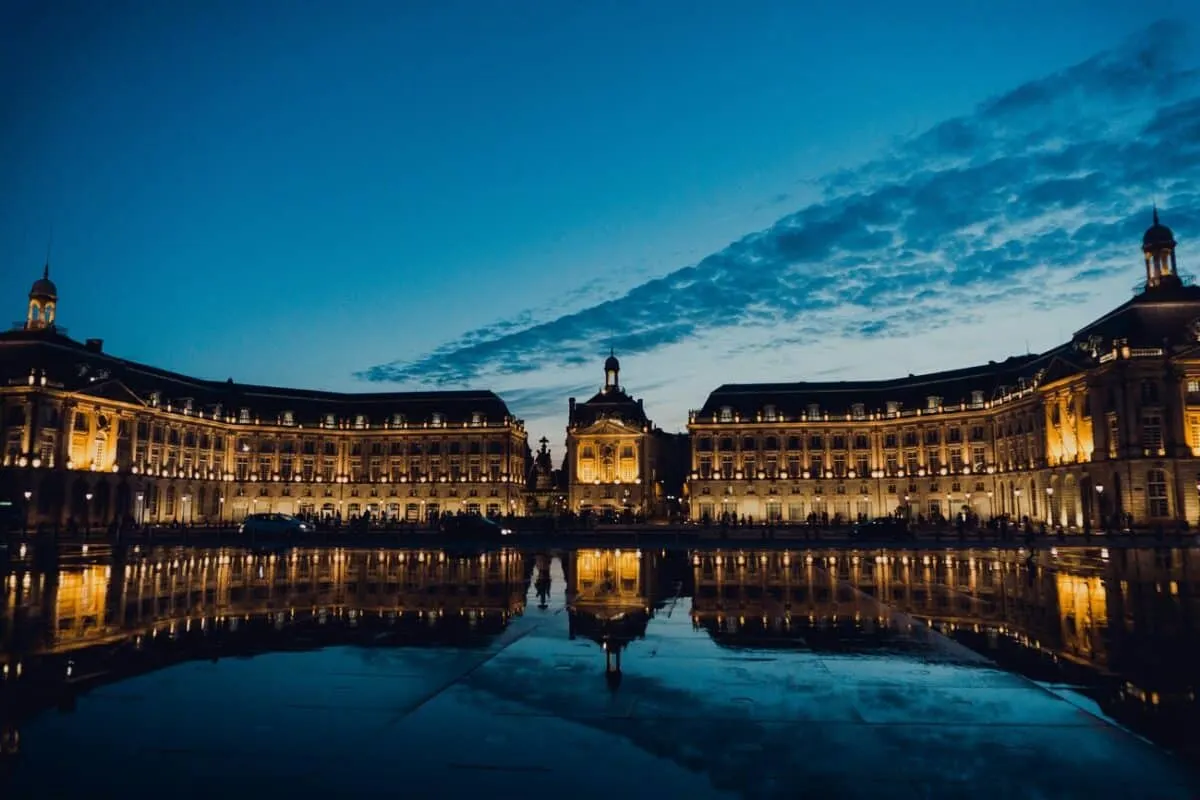
When it comes to Bordeaux, France, the first thing we usually think of is wine, but there is so much more to this city than that. While wine is a big part of Bordeaux’s culture, this city’s food, museums, and history are also huge drawcards.
Living just a 45-minute train ride away, I’ve discovered something different on each trip. There is something for everyone, from the famous entrecôte steak restaurant to a submarine base, now transformed into a digital art museum. But what are the best things to do in Bordeaux, France? What would I recommend as the “must see” places from a local’s perspective?
Whether you’re a first-time visitor to France or simply looking for somewhere new to explore, the historic port city of Bordeaux won’t disappoint. So get ready to pack your bags as you’re about to fall in love with the wine capital of France.
Where Is Bordeaux and What Is It Known For?
Bordeaux is the principal city in the Aquitaine region of southwest France and is a port city on the Garonne River. Founded by the Romans in 60 BC, it became an important hub for trade and commerce.
Bordeaux was part of the Duchy of Angouleme, and in the 12th century, Eleanor of Aquitaine became the first duchess to inherit the lands after her father died. In Bordeaux, she married Louis VII and became Queen of France.
During the Middle Ages, Bordeaux flourished under English rule when Eleanor married Henry II of England in 1152, her first marriage having been annulled. This period saw the rise of Bordeaux as a major wine exporter.
In the 18th century, Bordeaux experienced significant economic growth. The city’s port was one of the busiest in France, trading in goods such as sugar, coffee, and slaves.
12 Places To Visit in Bordeaux
To make the most of Bordeaux, you really need 4-5 days as there is so much to see and do, especially if you want to fit in a day at a nearby wine chateau. The cellars and wine estates on the left-bank and right-bank are perfect for wine lovers looking to learn more about the wine industry.
The places I suggest are all easy to reach using the tram, which goes around the city and is free to use if you have the Bordeaux City Pass.
1. La Cité du Vin
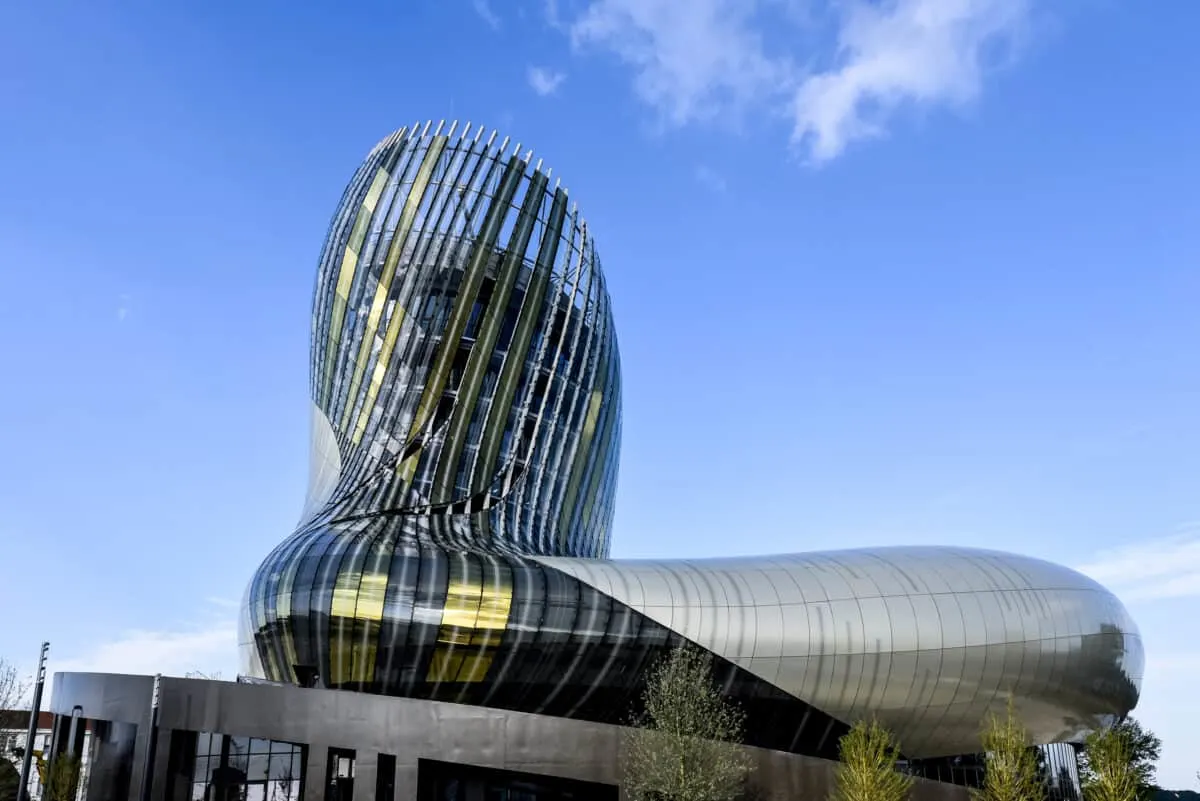
You can’t miss La Cité du Vin, the Wine Museum, as it rises above everything on the Bordeaux skyline. It’s built to represent the flow of wine into a glass, and when you see it, you’ll understand why.
I recommend setting aside about half a day to visit, as there is so much to see and do. But don’t be fooled into thinking this is just a chance for Bordeaux to show off its wine culture — it isn’t. It covers winemaking from around the world and takes you on a digital tour of the history of wine throughout the ages.
The Five Senses buffet bar is one of the museum’s interactive parts, and it’s a lot of fun, along with the virtual dinner table. Once you’ve finished exploring, take the elevator to the 8th floor for 360-degree views of Bordeaux and the countryside. Here, you can enjoy your complimentary glass of Bordeaux wine.
After all, you can’t come to Bordeaux and not indulge in some wine tasting. The Bordeaux region is famous for its wine and should be part of your sightseeing itinerary.
One thing to remember is that it isn’t in the city center, so you’ll need to take the tram, which takes about 20 minutes.
2. Les Halles de Bacalan
Across the road from Le Cité du Vin is Les Halles de Bacalan, a great place to go after visiting the wine museum. You’re likely to have worked up an appetite, and here, you can try some authentic Bordeaulaise food.
There are quite a few markets in the city of Bordeaux, but this one is a covered market which opened in 2017. Many of the stalls here are set up for eating, and it’s quickly become a favorite spot for both locals and tourists.
The emphasis is on local producers and artisans, and along with the usual culprits like the gourmet fromagerie, boulangerie and boucherie, you’ll also find plenty of regional specialties like canelés, foie gras, and duck confit.
Bordeaux is famous for its gastronomy and wine, making it an excellent place to pair food and wine.
3. Miroir d’eau
As you walk along the Garonne River, you’ll come across the Miroir d’eau, which becomes a reflective pool in the spring and summer months. It was designed by landscape artist Michel Corajoud and inaugurated in 2006. It covers an area of 37,000 square feet.
A thin layer of water washes over a granite slab, creating a reflective surface that reflects the surrounding architecture. The system alternates between a reflective pool and a misting effect, operating in a 15-minute cycle.
On a hot summer day in Bordeaux, this is one of the best places to be. It was too much for me to resist last year when we had a blisteringly hot 35-degree day. It really was the best way to cool down.
It looks pretty ordinary when it’s not in operation, but it takes on a new life when switched on. You can get some seriously stunning pictures as the mist rises on a hot day with the gorgeous architecture of Place de la Bourse behind it.
However, remember to visit before October, as it usually shuts down and doesn’t open again until the spring.
4. Place de la Bourse
This square is stunning, overlooking the Mirroir d’eau. It’s the perfect place for people-watching with a glass of wine, especially on a hot summer day when people are cooling off in the mists of water from the mirroir.
The Square, designed by architect Ange-Jacques Gabriel and completed in 1755, was created to celebrate Louis XV and the rise of Bordeaux as an important trade port.
It is part of the Port La Lune UNESCO World Heritage Site and is an excellent example of 18th-century French architecture. In the middle of the square is a beautiful fountain, the Fountain of the Three Graces, named after three daughters of Zeus: Aglaea, Euphrosyne, and Thalia.
5. Les Bassins de Lumières
Les Bassins de Lumières is my favorite museum in Bordeaux. If you’re staying in the city for a few days, carve out some time to go, you won’t regret it. It’s set in an old submarine base and displays digital artwork on the walls, all set to music and reflecting on the water. It only opened in 2020 and is now one of the largest digital art spaces in the world, covering 14,000 square feet.
Works such as van Gogh’s masterpieces “Starry Night” and “Sunflowers” are projected onto the walls, and opera is played through the loudspeakers. It’s a surreal experience but one that will take your breath away. The movement of the paintings is perfectly in sync with the music, and you feel as if you’re going on a journey with the artist.
It’s not in the town center; you must catch a tram. I recommend allowing yourself an hour before the entry time on your ticket because it is a good ten-minute walk from the tram stop.
6. Bordeaux Cathedral (Saint-André)
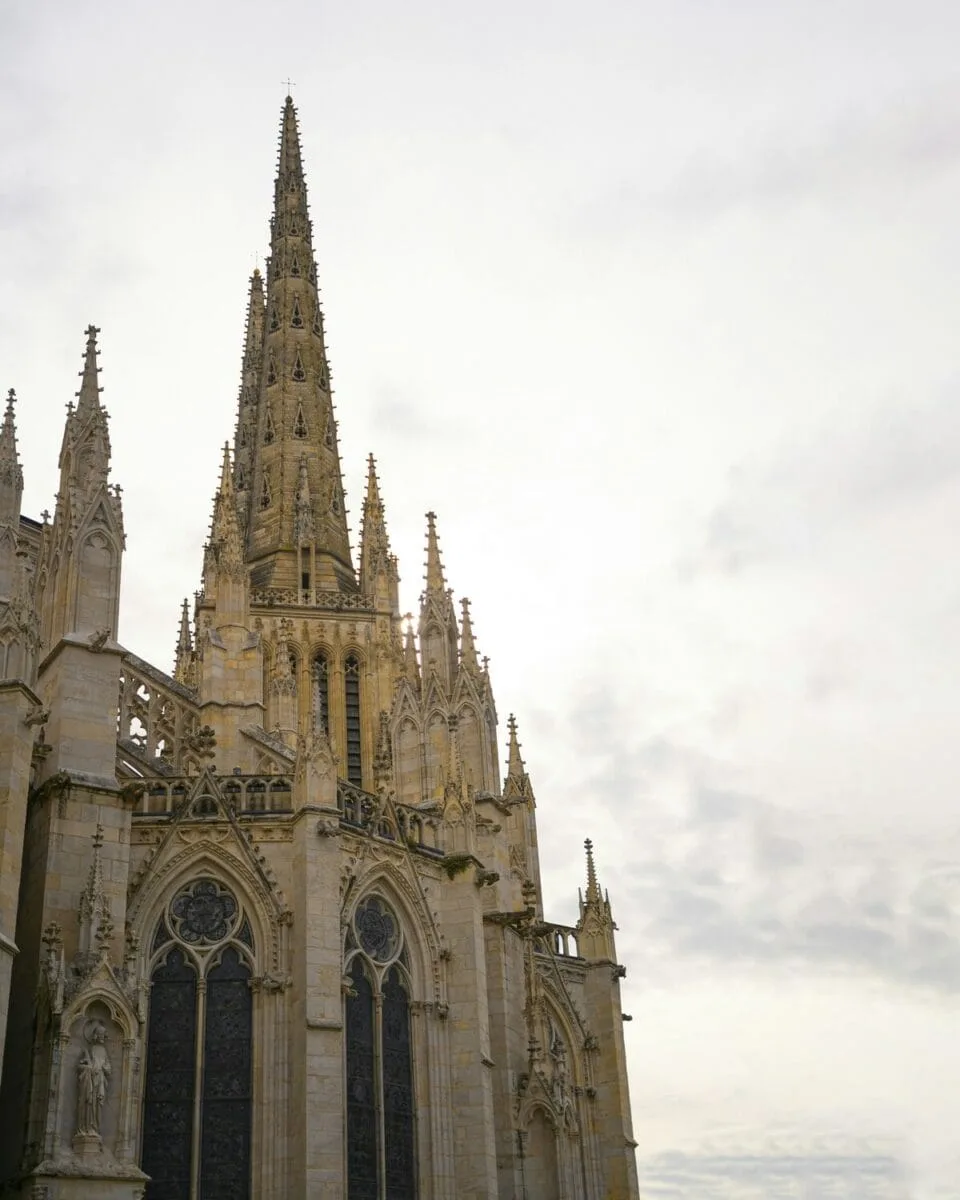
The spire of Pey-Berland Tower marks the spot of the cathedral, so you can’t miss it. It was a Romanesque church consecrated in 1096 by Pope Urban II, and most of its original structure dates back to the 12th century. Significant expansions and renovations occurred in the 13th and 14th centuries.
On November 1st, 1137, in the Bordeaux Cathedral, 15-year-old Eleanor of Aquitaine married the 17-year-old Dauphin of France, who became King Louis VII two years later.
Major restoration work was undertaken in the 19th century, led by architect Paul Abadie. This is the same architect who won a competition to design the Sacré-Cœur Basilica in Montmartre in 1873, which might explain some of the Gothic architecture.
7. La Grosse Cloche
La Grosse Cloche means “big bell,” and some bigger cities, like Rouen and Dijon, also have something similar. Initially, the building was part of the 13th-century defensive structures that once surrounded Bordeaux, a fortified city. It was one of the five entry points into Bordeaux.
However, the bell tower wasn’t constructed until the 15th century. The bells were only rung on important occasions, such as to announce the harvest or to let the townspeople know if there was a fire.
Like the clock at the Cathédrale Notre-Dame of Strasbourg, the Grosse Cloche is an astronomical clock added in the 18th century.
The towers were also used as a prison throughout the years, and prisoners were held there while awaiting trial.
8. Grand Théâtre de Bordeaux
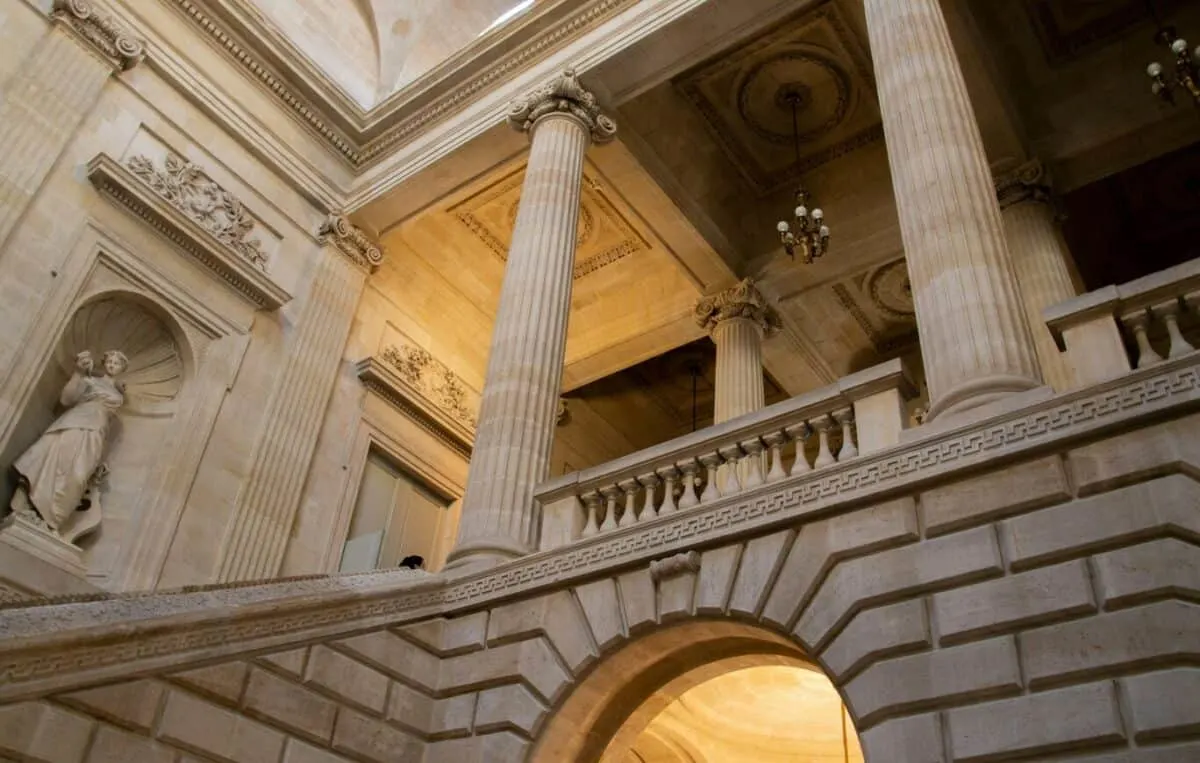
The Opera House of Bordeaux sits on the Place de la Comédie. It was completed in 1780 and was commissioned by the Duke of Richelieu to promote the arts in Bordeaux.
As you stand outside, if you look up, you’ll see twelve small statues on the roof sat on twelve Corinthian columns. They represent nine muses and three goddesses. The muses are each associated with a specific domain of the arts and sciences, and the three goddesses are Juno, Venus, and Minerva.
Inside is a grand sweeping staircase, part of the horseshoe-shaped auditorium. On the ceiling is a beautiful fresco painted by Jean-Baptiste-Claude Robin.
It’s home to the Opéra National de Bordeaux and the Ballet de l’Opéra National de Bordeaux hosting operas, ballets, concerts, and theatre productions.
9. L’Entrecôte
If you visit Bordeaux, you must try L’Entrecôte, next to the opera house. It’s a steak restaurant that sells only one thing, which, of course, is steak. You can’t make a reservation, so get there midday on the dot as the queues are long. I once queued for over an hour in the rain.
When you finally get in, you won’t be presented with a menu; instead, they’ll take your drink order and ask you how you like your steak. They’ll then serve you a walnut salad entree with the traditional bread basket, followed by the most amazing steak I have ever had, entrecôte.
But the special sauce they’re famous for makes this dish, and the french fries are to die for. Plus, you can have as many refills of fries as you want.
10. Rue Sainte-Catherine
After all that food, wander on rue Sainte-Catherine, the longest shopping street in Europe, stretching for three-quarters of a mile.
It dates back to Roman times when it was one of the main routes through the city. Now, you’ll find all sorts of fabulous French cafes, boutiques, market stalls, and the famous Galeries Lafayette.
11. Place des Quinconces
A bit further down from L’Entrecôte is Place des Quinconces, one of the largest city squares in Europe. It was created in the early 19th century on the site of the Château Trompette, an old fortress.
Its name comes from the quincunx pattern of trees planted in the square, arranged in a grid with staggered rows.
The Monument to the Girondins, which catches your eye, was erected between 1894 and 1902. It commemorates the Girondists, a political faction during the French Revolution.
Right at the top, you’ll see a statue of Liberty breaking its chains, a nod to abolishing the monarchy.
12. Musée des Beaux-Arts
Finally, the Musée des Beaux-Arts is located within the grounds of the Palais Rohan, which also houses the City Hall.
If you love art, this museum is definitely one to put on your list, although it’s one of several good museums in Bordeaux. It was founded in 1801 by a decree from the French Consulate as part of a broader initiative to create regional art museums across France.
The museum’s collection spans from the Renaissance to the 20th century, featuring works by renowned European artists such as Rubens, Titian, Veronese, and Delacroix.
This article originally appeared on Travel Binger.
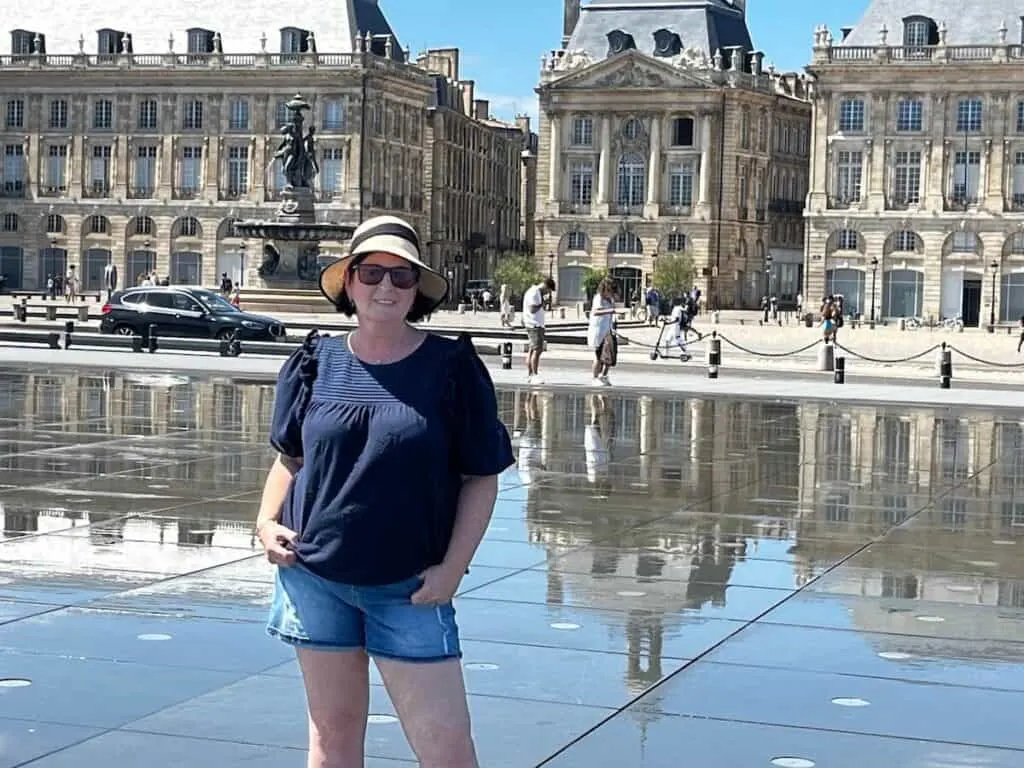
Kylie Lang is a travel journalist and blogger at Life In Rural France. As an accredited travel journalist with the British Guild of Travel Writers, Kylie can be found on Instagram, TikTok and Facebook. She has been featured in publications such as The Good Life
France, Expat Life, Salut From Paris, Seasonal Cravings and Amateur Traveler.


